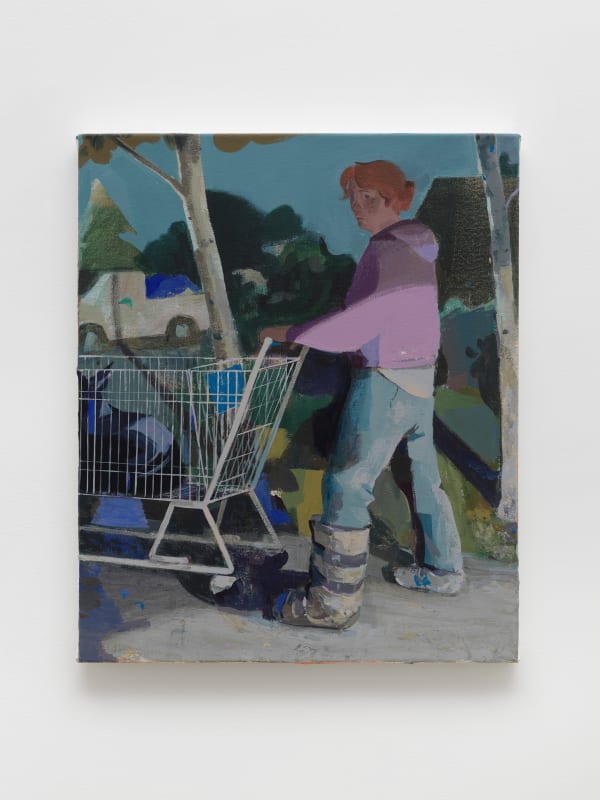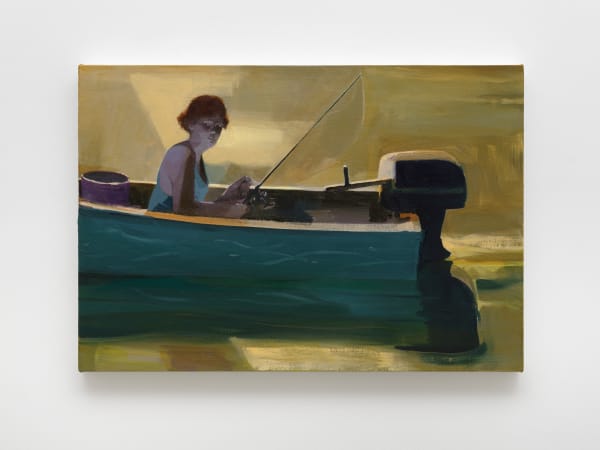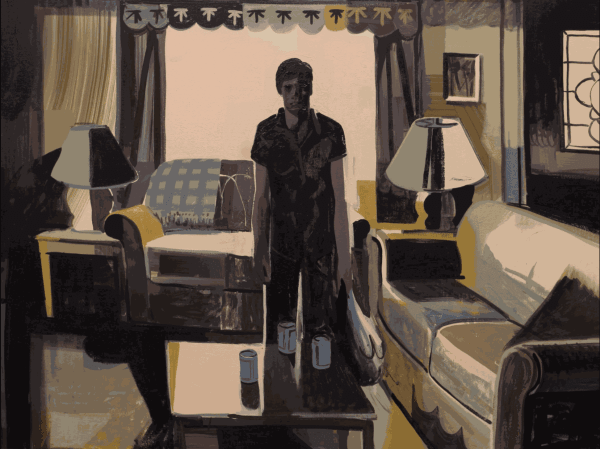Matt Bollinger: Station
François Ghebaly is proud to present Station by Matt Bollinger.
Ithaca-based artist Matt Bollinger works from a complex interdisciplinary base: as painter, draftsman, animator, and elegist, he creates work that straddles the projects of both visual art and narrative fiction. His stories, by and large, are of America’s rural working class–each is told through a bricolage of memory, family history, direct observation, art-historical research, and literary invention. For his latest exhibition, Bollinger chronicles the semi-fictional inhabitants of a rural central Missourian community, offering in the process ruminative, disillusioned vignettes of the real ‘American Dream.’
Spanning the far wall, Uncle Dave (2023) is the most ambitious work in Bollinger’s show–with its impressive vertical dimension, some eight feet-tall, the painting acts as an anchor to the New York gallery space, drawing the eye in and upward. The work depicts three sanitation workers surrounding the bright yellow cab of a dump truck. Framed by wildflowers underfoot and the scintillating glare of another truck’s headlight, the men are shown in progressive life stages. At the far right, the youth holds a rake and stares listlessly out of view. The middle-aged man, partially obscured, gestures forward with a lighter and a yellow traffic flag, while the eldest is positioned above the other men and descends from the cab, directly confronting the viewer’s gaze. The work’s triadic symbol of labor, class, and the passage of time–alongside compositional affinities, somewhere between Courbet and religious genre painting–underscores many of the themes latent both in the exhibition title and in the artist’s work at large.
Uncle Dave, like each of Bollinger’s paintings in Station, is a remarkably considered image. Working largely from drawing, Bollinger devises and constructs his paintings (all works are Flashe and acrylic on canvas) around observation, art-historical reference, and invented scenery, often bringing compositional elements into the studio for research and the application of meticulous light study. The results are unequivocally immersive–“mosaics of moments and decisions over time, compressed onto a surface.” Of course, Bollinger’s subjects are just as compelling. Buoyed by an early interest in creative fiction and American modernism (as well as personal and familial origins outside Kansas City, not far from the Ozarks), Bollinger has honed a narrative style empathetically devoted to the portrayal of America’s rural, predominantly white, and uniquely disenfranchised working-class. The townspeople in Station are blue-collar folk–local entrepreneurs, agricultural workers, and “gleaners.” Many are, even for the artist, challenging or uncomfortable figures. The specters of alcoholism, neglect, misogyny, class division, and troublesome political alignment loom at the edges of many of his scenes; in Stoop (2023), a woman’s routine cigarette break is interrupted by the potentially menacing reach of a tattooed forearm from beyond the canvas. Throughout, though, his images retain a great degree of neutrality–they’re offered without interpretation, pejorative instruction, or cut-and-dry political pedagogy. Much of the work is entrusted to the viewer, to sift through Bollinger’s pastorales for a clear imperative of their own.
In the adjoining room, Bollinger presents his 2017 stop-motion short film, Between the Days. At over 18 minutes long, the work uses an entirely hand-painted technique; each ‘camera angle’ comprises a single painting, which is changed incrementally, photographed, and then repeated to produce the stop-motion effect. The story is quite literally propelled by Bollinger’s brushstrokes, with many views gaining an abstracted, almost expressionistic quality from the sequential layering of movement and light. Between the Days follows, over the course of one day, the lives of a working mother and her adult son. Set primarily in a suburban home whose floor plan is modeled after Bollinger’s parents’ own, the film explores both the intimacy and oppressiveness of routine. Between scenes of the mother’s monotonous factory job, the son tidying beer cans and cigarette ashes from the night before, or beams of sunlight tessellating through the glass filigree on the front door, the film brims with a surfeit of evidence of each character’s inward life: devotional calendars and kitschy office magnets; heavy metal cassettes and Arnold Schwarzenegger posters; relics of dreams and memories that punctuate the otherwise monotonous course of their everyday. Like the unremitting TV murmur in a suburban home, Between the Days plays almost as a backing track to the exhibition–a poignant and illuminating study of Bollinger’s divided, undoubtedly misunderstood America.
Matt Bollinger (b. 1980 Kansas City, MO) was awarded a BFA from Kansas City Art Institute (2003) and an MFA from Rhode Island School of Art and Design (2007). His recent solo exhibitions include mother’s tankstation, Dublin and London; Zürcher Gallery, New York and Paris; and M+B, Los Angeles. Bollinger’s work has featured in recent museum exhibitions including The Westmoreland Museum of American Art, Greensburg, Pennsylvania (2022); South Bend Museum of Art, Indiana (2020); Phillips Museum, Lancaster, Pennsylvania (2018); Nerman Museum, Overland Park, Kansas (2016); and Musée d’art Moderne et Contemporain, Saint-Etienne (2016).












